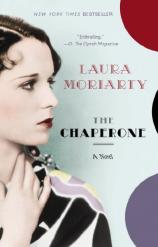Author Talk: June 8, 2012
In her new novel, THE CHAPERONE, Laura Moriarty reimagines silent film star Louise Brooks as a 15-year-old girl coming to New York for the first time with her chaperone, Cora Carlisle. At first, Louise is annoyed by Cora’s presence, but the five weeks they spend together ultimately will transform them. In this interview, conducted by bestselling author Curtis Sittenfeld, Moriarty discusses the extensive research she did into the actress’s life. She also talks about being a writer in Kansas and shares a juicy story about Louise that didn’t make it into the book.
Curtis Sittenfeld: You tell the story of two characters whose trajectories overlap --- Louise Brooks before she becomes famous, and quietly complicated housewife Cora Carlisle, who serves as 15-year-old Louise’s chaperone in New York in the fateful summer of 1922. Did you always know they belonged in a book together, or did you decide to write about one of them first?
Laura Moriarty: I always found Louise Brooks interesting. She was an icon of the silent–film era, and I knew she’d grown up in Kansas, and that she was smart and rebellious and sharp-tongued. But it wasn’t until I learned that she’d first gone to New York as a teenager with a 36-year-old chaperone that I saw a story I wanted to write. I’m drawn to intergenerational tension, and it must have been strong in the 1920s: I wondered how Louise’s generation of flappers appeared to the women who came of age at the beginning of the century --- wearing corsets, long skirts, and high collars. This older generation of women had campaigned for suffrage and prohibition of alcohol; they must have been bewildered by the very different values and sensibilities of their daughters. I liked the idea of a chaperone, someone thrown into this dynamic all at once.
CS: Were you a fan of Louise Brooks specifically, or of movies from the 1920s and 1930s generally, or were you exploring an art form unfamiliar to you when you started writing this novel?
LM: I wasn’t that familiar with silent films. I didn’t know, for example, how hugely popular silent films were in the 1920s, how people would go to the movies several times a week. While I was writing the book, I went to see Louise Brooks’s most famous film, Pandora’s Box, at the Tivoli in Kansas City, and it was a lovely experience. You can watch old silent films on DVD or even on YouTube, but it was a different feeling watching her up on the big screen, seeing the film the way people saw it all those years ago.
CS: You’ve clearly done a lot of research. What form did your research take? Were there discoveries you made --- about Brooks, or the early twentieth century, or Wichita --- that particularly captured your imagination? Were there any incredibly juicy details you came across that just didn’t belong in the book?
LM: One of the first things I did, and maybe the most important, was drive down to Wichita and walk around Union Station, where Louise and her chaperone disembarked for New York in 1922. It’s boarded up now, but just seeing the physical place helped me see the story and the journey as real. I read Louise’s autobiography and Barry Paris’s biography of her. I read oral histories of Manhattan in the ’20s, and I read travel guides from that era as well. I spent a lot of time learning about 1920s fashion, not just what flappers were wearing, but what most women were wearing, what men were wearing. Overall I learned a lot of details about 1920s clothes, cars, kitchen appliances, and food. I had a character eating peanut butter in one scene until I learned that peanut butter wasn’t commercially packaged and sold until 1924. But the biggest challenge was probably getting into the psychology of someone living in that era --- to know her values, and how she saw the world.
Here’s an interesting bit about Louise that didn’t get in the book: After she became famous, she and some friends were dining in a restaurant in Europe; she was bored, and she spotted a man she’d been friendly with, and she asked the waiter to summon him. The man didn’t come over right away because he was with a woman, and he didn’t want to be rude. When he finally did go over to Louise’s table, apologizing and explaining his delay, she picked up a bouquet of roses and sliced him across the face with it, the thorns actually cutting his skin so his face was dripping blood. This story, to me, says a lot about the dark side of Louise’s personality. Yes, she was beautiful and intelligent, and she could be very funny, but obviously there was a deep insecurity there, a real destructive rage and immaturity. I couldn’t work that scene into the book, but I knew what it told me about Louise, and I thought about it when I was writing her scenes with Cora.
CS: One of your characters was part of the Orphan Train, which placed children with midwestern families (who also happened to be strangers!). Is her experience based on that of anyone real, or is it more of an amalgamation?
LM: The thing that got me about the Orphan Trains was that the experiences were so varied. Some of the kids went from neglect and hunger in New York to loving farm families who couldn’t wait to fatten them up, who gave them medical care, an education, affection. And some of the kids became the victims of terrible cruelty, and more hunger, and more neglect --- it all depended on who adopted them off of the train. Because the experiences of the children were so varied, I wouldn’t say this character’s experience is an amalgamation, though she isn’t based on any one real person either. Her story is just what could have happened to a child, and what probably did happen to many of them.
CS: Like Cora, you yourself live in Kansas, and you’ve set earlier fiction there. What do you like about writing and living in a place that’s not considered a literary hotbed? (Admittedly, I ask this as someone who lives in nearby Missouri!)
LM: I love my town, Lawrence, Kansas, so I’m glad I get to live here. I’ve never felt that wanting to write required me to live in New York. There are so many great authors living there, of course, but I can get their books here, or I can read their stories online or in journals. And there’s a great community of writers right here in my town. I teach creative writing at the University of Kansas, and I have creative colleagues and thoughtful graduate students, and I have a writing group I meet with almost every week. I suppose it’s a little humbling to write from Kansas. I know I’m not at the literary center of the universe. But that might not be a bad thing.
CS: I want to ask you a variation of a question I’ve been asked. I wrote a novel, AMERICAN WIFE, that borrowed from the life of a real person --- Laura Bush --- but I changed her name. You’ve written about a real person --- Louise Brooks --- and used her real name, but she’s no longer living. Do you feel any moral qualms about portraying a real person saying and doing things that you’ve made up?
LM: I was so excited about this book when I started it that I didn’t have a lot of moral qualms. But the more I read about Louise and the more I wrote about her, the more I started to really care for her, and I did worry about getting her right, portraying her in a way that was accurate. I tried to keep my depiction true to what I learned from her autobiography and biographies about her. It’s impossible to know what she’d think of my portrayal, but I hope she would approve. In any case, I don’t think Louise Brooks ever lost too much sleep over what other people thought of her.
CS: Your descriptions of Cora wearing a corset are incredibly convincing. Did you --- for the sake of research, of course --- ever try one on yourself?
LM: I don’t think I’ve ever tried on a corset, though a certain bridesmaid’s dress did require a torturous bustier that will stay forever burned in my sensory memory.




